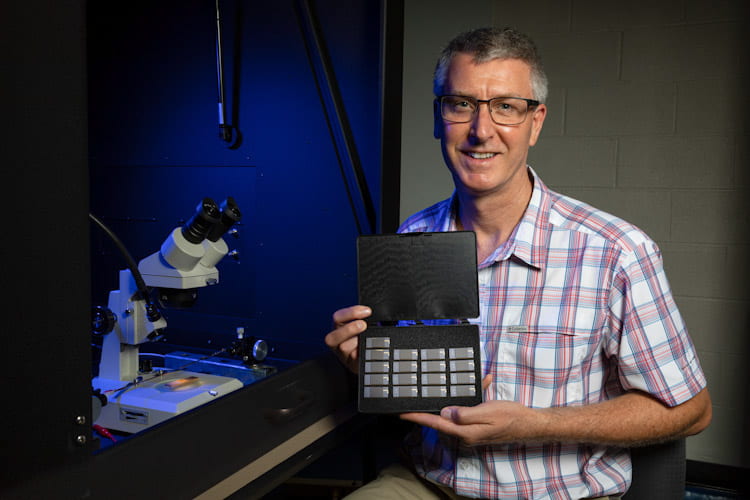
Limitless: Paul Thibado holds prototype energy-harvesting chips. (Courtesy: Russell Cothren)
The rippling thermal motion of a tiny piece of graphene has been harnessed by a special circuit that delivers low-voltage electrical energy. The system was created by researchers in US and Spain, who say that if it could be duplicated enough times on a chip, it could deliver “clean, limitless, low-voltage power for small devices”.
Brownian motion is the random movement of a tiny particle that is buffeted by atoms or molecules in a liquid or gas – and the idea of harnessing this motion to do useful work has a long and chequered history. In the early 1960s, the Nobel laureate Richard Feynman popularized a thought experiment known as the “Brownian ratchet”, which had been conceived in 1912 by the Polish physicist Marian Smoluchowski. This involves a paddle wheel that is connected by an axle to a ratcheted gear. Both the paddle wheel and the ratchet are immersed in fluids. The system is imagined as being small enough so that the impact of a single molecule is sufficient to turn the paddle. Because of the ratchet, the paddle can only turn in one direction and therefore it appears that the Brownian motion of the paddle can be harnessed to do the work of turning the axle.
However, Feynman showed that if the two fluids were at the same temperature, collisions throughout the system would prevent this from happening. The only way work could be done, argued Feynman, is if the fluids are a different temperature, making the Brownian ratchet a heat engine.
Freestanding graphene
In their new study, University of Arkansas physicist Paul Thibado and colleagues replaced the paddle with a freestanding sheet of graphene – a single layer of carbon atoms. In a 2014 study, the team used scanning tunnelling microscopy to discover that graphene ripples back and forth at room temperature like a wave on the surface of the ocean. Indeed, these ripples provide the sheets with the stability they need to exist.
The team’s energy harvesting circuit features a graphene sheet that ripples next to an electrode. As the sheet ripples from concave to convex – alternately getting closer to and further away from the electrode – the pair behave as a variable capacitor that produces an alternating current.
In their new circuit design, the team combined this variable capacitor with two opposing diodes wired in parallel. This created two separate paths for the current as it flows in each direction. In this way, one of the paths can be used to charge up a storage capacitor that can later be emptied to perform work, such as in lighting up a bulb or powering a similar component (see video).
The researchers report that their dual-diode system serves to boost the power: "We also found that the on-off, switch-like behaviour of the diodes actually amplifies the power delivered, rather than reducing it, as previously thought," explained Thibado. "The rate of change in resistance provided by the diodes adds an extra factor to the power.”
"Symbiotic" relationship
But how does this setup work when the Brownian ratchet fails? The researchers explain that success lies in how the graphene and the circuit share a "symbiotic" relationship. Even though the circuit allows the thermal environment to do work on the load resistor, the circuit and the graphene operate at the same temperature, meaning that no heat flows between the two.
"This means that the second law of thermodynamics is not violated, nor is there any need to argue that 'Maxwell's Demon' is separating hot and cold electrons," Thibado explained.
He points out that the operation of the new device is not based on an old notion that a single diode could be used in such a circuit to allow high energy electrons to flow by while blocking low energy ones. This idea was dismissed in the 1950s by the French physicist Léon Brillouin because it would cause one side of the diode to heat up. This would lead to particles flowing from cold to hot, violating the second law of thermodynamics.
Rerouted current
"People may think that current flowing in a resistor causes it to heat up, but the Brownian current does not. In fact, if no current were flowing, the resistor would cool down," Thibado added. "What we did was reroute the current in the circuit and transform it into something useful."
"An energy-harvesting circuit based on graphene could be incorporated into a chip to provide clean, limitless, low-voltage power for small devices or sensors," he adds.
With their initial study complete, the researchers are now working to store enough of the DC current produced by the energy-harvesting circuit within a capacitor for later use – a goal that will require the miniaturization of the circuit and its patterning on a silicon wafer or chip. Should it prove possible to duplicate the circuit millions of times over on a one square millimetre chip, Thibado says, "this can be a battery replacement".



